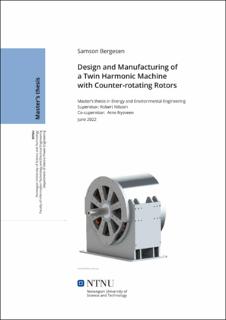| dc.contributor.advisor | Nilssen, Robert | |
| dc.contributor.advisor | Nysveen, Arne | |
| dc.contributor.author | Bergesen, Samson | |
| dc.date.accessioned | 2022-10-18T17:21:19Z | |
| dc.date.available | 2022-10-18T17:21:19Z | |
| dc.date.issued | 2022 | |
| dc.identifier | no.ntnu:inspera:108946158:35759417 | |
| dc.identifier.uri | https://hdl.handle.net/11250/3026834 | |
| dc.description.abstract | Konseptet med å drive to rotorer som kan rotere i separate retninger i samme stator ved å bruke harmoniske komponenter i et konsentrert viklingsoppsett i en overflatemontert permanentmagnetmotor har blitt undersøkt. Konfigurasjonen av et antall spor og poler for en slik motor ble undersøkt, og en stator med 24 spor og to rotorer med 22 og 26 poler ble valgt. Det ble gjort en harmonisk analyse på denne konfigurasjonen, og det ble konkludert med at den burde kunne drive en kontra-rotasjon. Parametrene for et motordesign med den valgte spor- og polkonfigurasjonen ble først utført analytisk. Deretter ble parametrene simulert ved hjelp av FEM-programmet COMSOL. COMSOL bekreftet også kontra-rotasjonen. Ved å bruke motorparametrene ble en prototype designet ved bruk av SOLIDWORKS. Den designede prototypen ble deretter produsert og testet. Til slutt bekreftet en funksjonstest utført på prototypen at en "twin harmonic motor drive" er mulig. | |
| dc.description.abstract | The concept of driving two rotors that can rotate in separate directions within the same stator by utilizing harmonic components of a concentrated winding layout in a surface-mounted permanent magnet motor has been investigated. The configuration of a number of slots and poles for such a motor was examined, and a stator with 24 slots and two rotors with 22 and 26 poles was chosen. A harmonic analysis was done on this configuration, and it was concluded that it should be able to drive a counter-rotation. The parameters for a motor design with the chosen slot and pole configuration were first analytically done. Then the parameters were simulated using the FEM program COMSOL. COMSOL also confirmed the counter-rotation. Using the motor parameters, a prototype was designed using SOLIDWORKS. The designed prototype was then produced and tested. Finally, a function test performed on the prototype confirmed that the twin harmonic motor drive is possible. | |
| dc.language | eng | |
| dc.publisher | NTNU | |
| dc.title | Design and Manufacturing of a Twin Harmonic Machine with Counter-rotating Rotors | |
| dc.type | Master thesis | |
